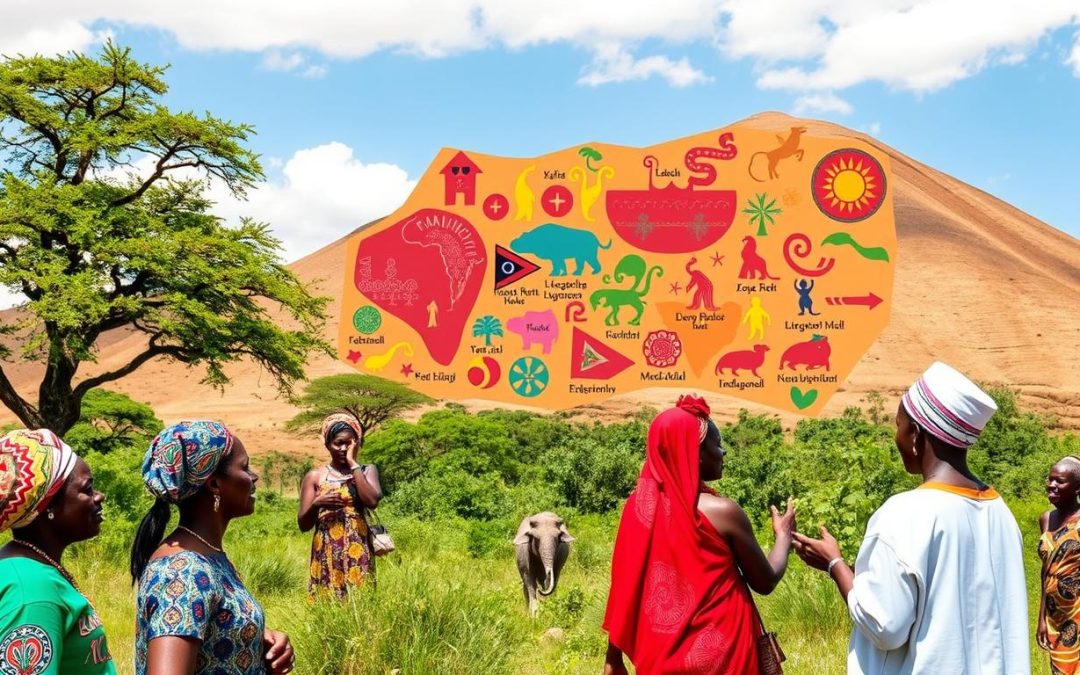Have you ever thought about how one country can have so many languages? Botswana is a great example of linguistic diversity. Here, languages blend together to create a rich cultural heritage.
In Botswana, language is more than just talking. It’s a way to understand the country’s heart. English is the official language, brought by colonial history. Setswana, on the other hand, connects communities across the land.
Botswana is home to 31 different languages. Setswana is spoken by 73.3% of the people. This language helps unite different ethnic groups and keeps their culture alive.
Key Takeaways
- English and Setswana are the official languages of Botswana
- 73.3% of the population speaks Setswana as their primary language
- Botswana hosts 31 different languages, representing remarkable linguistic diversity
- Urban centers predominantly use English, while rural areas maintain traditional languages
- Over 90% of the population speaks a Bantu language as their first language
Understanding Botswana’s Linguistic Landscape
Botswana is a vibrant multilingual society. Here, languages create a rich tapestry of cultural expression. The nation’s linguistic diversity shows its complex history and dynamic social interactions.
The language ecosystem in Botswana is intricate and fascinating. With over 25 different languages spoken, the country’s linguistic landscape tells a story of cultural heritage and social evolution.
Historical Development of Languages
Botswana’s language history is rooted in indigenous traditions and colonial influences. Missionaries and British colonial administrators introduced English, while preserving native languages.
- Over 80% of the population speaks Setswana
- English serves as an official language alongside Setswana
- Indigenous languages represent diverse ethnic group identities
Current Language Distribution
The linguistic diversity of Botswana is remarkable. Setswana is the most widely spoken indigenous language. Other languages like Kalanga and Sekgalagadi are also significant.
“Language is the road map of a culture. It tells you where its people come from and where they are going.” – Rita Mae Brown
Role of Languages in Society
Languages in Botswana are more than communication tools. They represent cultural identity, social connections, and community preservation. Each language has unique historical significance, from urban centers to rural communities.
| Language | Percentage of Speakers |
|---|---|
| Setswana | 73.3% |
| Kalanga | 17.2% |
| Other Indigenous Languages | 9.5% |
The commitment to preserving indigenous languages remains strong. Government policies support multilingual education and cultural pride.
English: The Official Language of Business and Administration
In Botswana, English is key for talking across different areas. It’s the official language, helping the country grow and connect with the world. The language policy makes English a main force for progress.
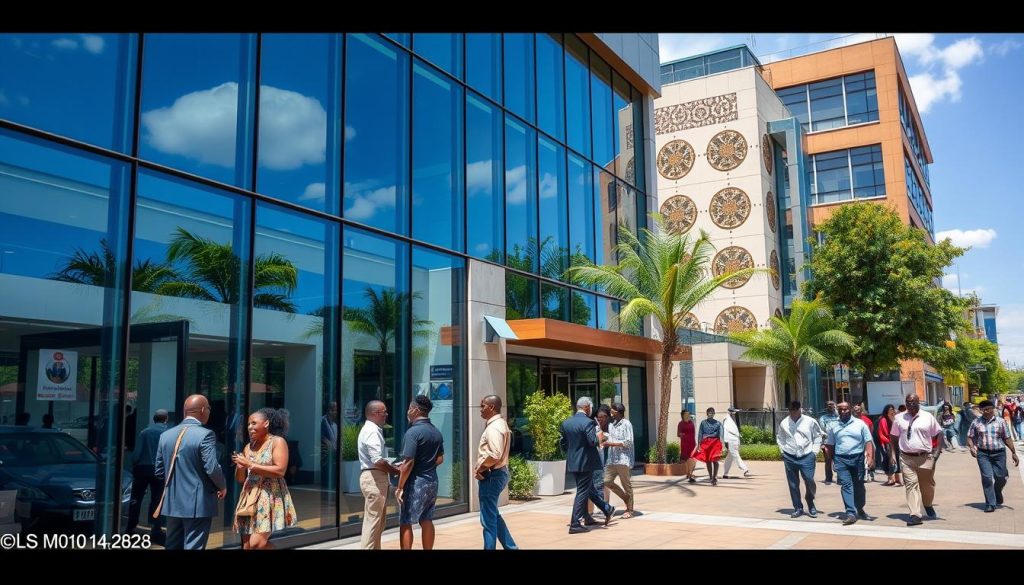
Usage in Government
English is the main language in Botswana’s government. It’s used for:
- Official documents
- Parliament talks
- Admin talks
- Diplomatic talks
Educational System Language
English is the main language in schools in Botswana. It’s used to teach many subjects. This helps students get ready for their future careers.
“English is not just a language in Botswana; it’s a bridge to global opportunities.” – Botswana Education Expert
Business Communication
In business, English is the main language for talking. It helps with both local and international trade. This makes Botswana a good place for investors from around the world.
| Language Aspect | English Usage in Botswana |
|---|---|
| First Language Speakers | 2.8% of population |
| Working Knowledge | Majority of residents |
| Business Communication | Dominant language |
| Government Official Language | Primary language |
English’s role in Botswana shows its importance. It’s not just for talking. It’s a key part of the country’s growth, linking local people to the world.
Setswana: The National Language and Cultural Heritage
Setswana is at the heart of Botswana’s culture. It’s spoken by almost 2 million people, showing more than just how to talk—it’s a symbol of national pride and heritage.
The language landscape of Botswana shows how important Setswana is:
- About 70-90% of Botswana’s people speak Setswana.
- Almost 79% say it’s their first language.
- It’s an official language in several southern African countries.
Learning Setswana opens a door to the rich culture of Batswana people. Linguistic details show deep traditions, from how people talk to family ties.
“Language is the roadmap of a culture. It tells you where its people come from and where they are going.” – Rita Mae Brown
Setswana is special among indigenous languages. It uses complex prefixes to show noun classes, showing its deep grammar and structure.
| Language Demographic | Percentage |
|---|---|
| Native Setswana Speakers | 70% |
| Setswana as Second Language | 20% |
| Other Language Speakers | 10% |
Even though English is used for writing, Setswana is the main language spoken. It keeps cultural stories alive and connects families in Botswana’s lively communities.
Botswana’s Language Policy Framework
Understanding Botswana’s language policy is complex. It balances national unity with cultural preservation. This balance is key to managing its diverse languages.
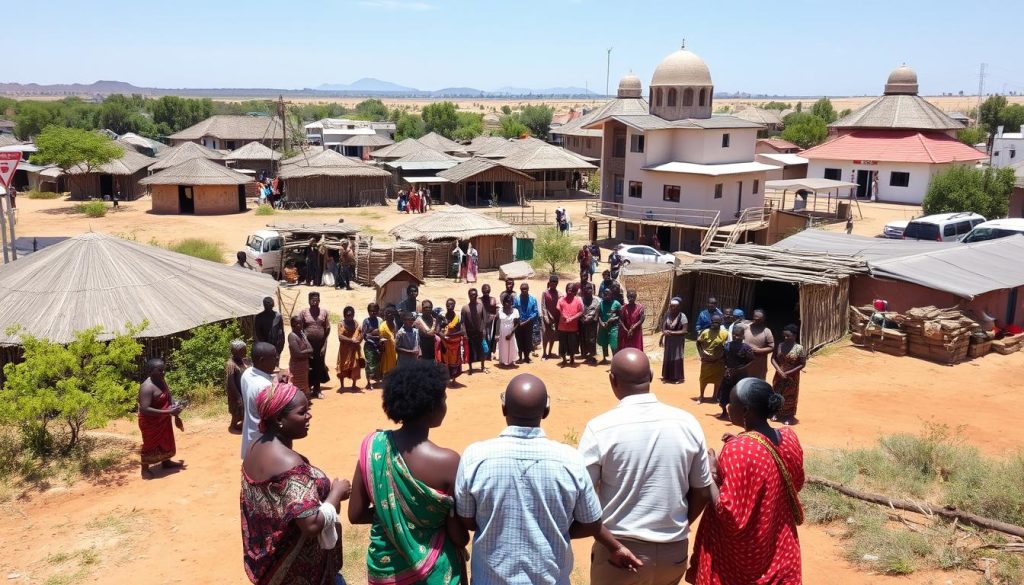
Botswana’s language policy is crucial for its multilingual society. With 28 ethnic languages, the country must create an inclusive communication space. This is a big challenge.
Key Components of Language Policy
- Official recognition of Setswana and English as primary languages
- Promotion of linguistic diversity while maintaining national cohesion
- Emphasis on bilingual education strategies
Implementation in Public Sectors
The language policy affects public sectors, especially education. Here are some key points:
- Only Setswana and English are used in schools
- Children from non-Setswana speaking areas often struggle in school
- Primary school leaving exam results show differences among language groups
Social Impact and Challenges
Botswana’s language policy has both benefits and drawbacks for its society. Marginalized groups like the BaZezuru and San face big language barriers. They find it hard to get into education and government services.
“Language is the roadmap of a culture. It tells you where its people come from and where they are going.” – Rita Mae Brown
There’s a push for a more inclusive education policy. It aims to value Botswana’s diverse languages more. This is essential for the country’s linguistic richness.
Major Bantu Languages in Botswana
Botswana’s language scene is full of diverse indigenous tongues. These languages show the country’s rich cultural background. Setswana is the most spoken, but other Bantu languages are also key in many communities.
Kalanga is a standout indigenous language in Botswana. About 7.4% of people speak Kalanga, showing its cultural and linguistic importance. It’s mainly spoken in the northeast, where it also has a presence in Zimbabwe.
- Kalanga: 7.4% of Botswana’s population
- Shekgalagari: Spoken by approximately 3.4% of residents
- Mbukushu: Represented by 1.6% of language speakers
Shekgalagari is another interesting Bantu language. It’s spoken in the Kgalagadi region, adding to Botswana’s language diversity. This language helps connect communities, keeping their stories and ways of speaking alive.
*”Languages are the roadmaps of a culture. They tell you where its people come from and where they are going.”* – Rita Mae Brown
Botswana’s language scene is incredibly varied. More than 90% of people speak a Bantu language first. The country has 31 living languages, with 26 being indigenous. This shows the complex cultural mix of Botswana’s communities.
| Language | Percentage of Speakers |
|---|---|
| Setswana | 77.3% |
| Kalanga | 7.4% |
| Shekgalagari | 3.4% |
These languages are more than just ways to talk. They are living parts of Botswana’s rich cultural heritage. Each language brings its own stories, traditions, and views, making up the nation’s diverse identity.
Indigenous Minority Languages and Their Preservation
Botswana’s language scene is rich and varied, with many indigenous languages at risk. Up to 30 languages are spoken here, but many are on the edge of disappearing.
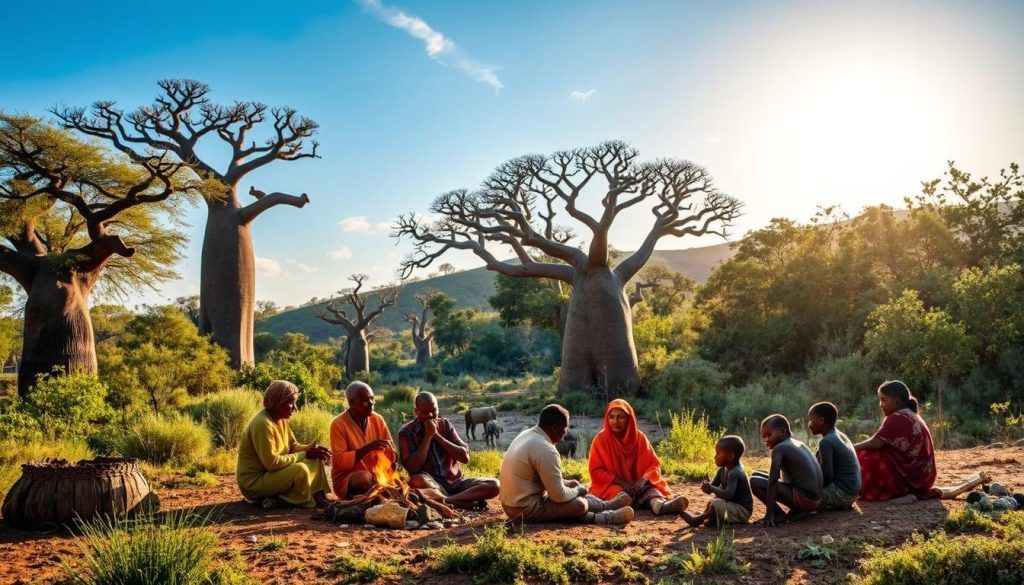
Keeping these languages alive is crucial for Botswana’s culture and language diversity. Some facts show how urgent it is to save these languages:
- At least 17 languages are rapidly losing ground
- Some Khoisan languages have fewer than 500 speakers
- The N/u language is spoken by only eight elderly women
Endangered Languages: A Critical Situation
Minority languages are spoken by fewer than 5,000 people, making them very vulnerable. Many lack written forms, making it harder to save them.
Conservation Efforts
Researchers and linguists are working hard to save these languages. They aim to document the rich linguistic heritage before it’s lost forever.
“Language is the roadmap of a culture. It tells you where its people come from and where they are going.” – Rita Mae Brown
Community Initiatives
Local communities are key in saving these languages. They use things like passing on languages to younger generations, cultural events, and education to keep them alive in Botswana.
Without quick and ongoing efforts, many languages could disappear in just a few generations. Your help and support can really help protect these precious languages.
Khoisan Languages in Modern Botswana
In Botswana, the Khoisan languages are a key part of the country’s heritage. They have unique sounds, like clicks, and are spoken by small groups in the Kalahari Desert.
The Khoisan languages in Botswana include several groups, such as:
- Sesarwa (San languages)
- Tshwa (Khoe language)
- ǃXóõ (Tuu language)
These languages are at risk. Only 1.7% of people speak Tshwa, and 0.1% speak ǃXóõ. This shows how urgent it is to save these languages.
“Language is the roadmap of a culture. It tells you where its people come from and where they are going.” – Rita Mae Brown
The Khoisan communities face big challenges. They are often ignored and lack resources. This makes it hard for them to keep their languages alive.
But, there are efforts to save these languages. Local groups are recording stories, teaching languages to kids, and finding ways to keep them alive.
Knowing about Botswana’s languages is important. They are more than just ways to talk. They connect people to their culture, traditions, and history.
Urban vs Rural Language Usage Patterns
Botswana’s language diversity shows interesting differences between cities and countryside. The country’s rich culture is reflected in how people communicate.
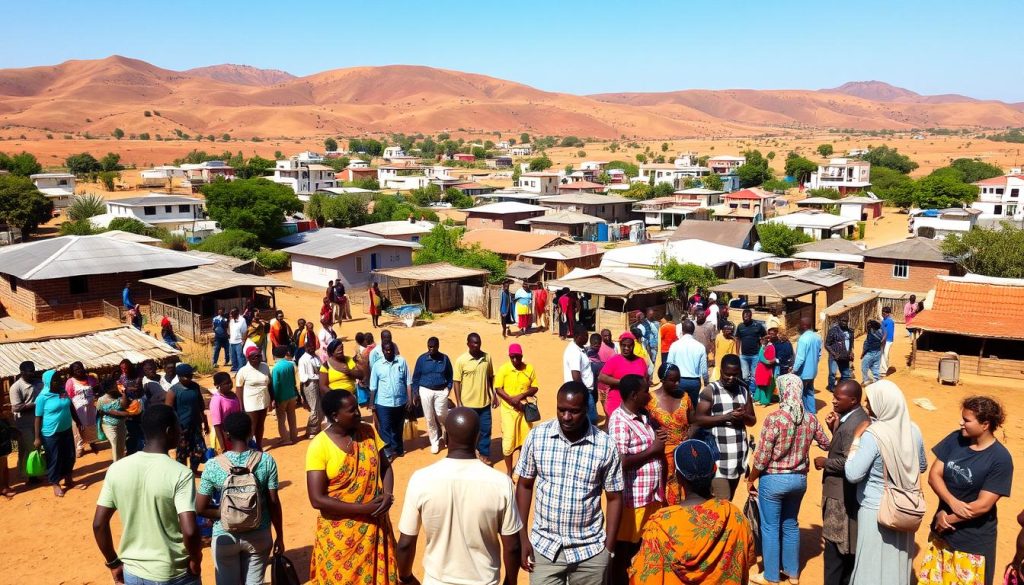
In cities like Gaborone, language use is more complex than in rural areas. Several factors influence this:
- Economic opportunities
- Educational access
- Migration patterns
- Cultural interactions
Metropolitan Language Trends
In cities, English is key for work and government. Studies show:
- 95% of documents in the Ministry of Commerce and Industry are in English
- 70% of government radio broadcasts use English
- Professional settings value speaking many languages
Rural Linguistic Diversity
In rural areas, indigenous languages are more common. About 80% of people speak Setswana. These areas keep their language traditions alive while adjusting to new ways of communicating.
Regional Variations
Language use changes a lot across Botswana. Near borders, languages mix more because of cultural exchanges with neighboring countries.
“Language is the roadmap of a culture. It tells you where its people come from and where they are going.” – Rita Mae Brown
Studying city and country language use helps us understand Botswana’s culture, identity, and language changes.
Foreign Languages and Their Influence
Botswana’s language scene is more than just its official tongues. It’s a vibrant mix of local and global languages. This diversity shows how different cultures blend together in the country.
Foreign languages are key in Botswana’s culture and economy. Many languages have shaped the way people communicate:
- Afrikaans: Common in border areas
- Chichewa: Used by immigrant groups
- Lozi: Heard in certain regions
- Zezuru: Adds to the language mix
Global tongues like French and Portuguese are becoming more important. They’re used in:
- International business talks
- Talking to tourists
- At universities
“Language is the road map of a culture. It tells you where its people come from and where they are going.” – Rita Mae Brown
Urban areas show more language variety than rural ones. Young people are especially mixing global languages into their speech. This shows Botswana’s growing ties to the world.
| Foreign Language | Primary Usage Area | Influence Level |
|---|---|---|
| Afrikaans | Border Regions | Moderate |
| French | Business/Tourism | Growing |
| Portuguese | International Exchanges | Emerging |
These foreign languages show Botswana’s openness to the world. At the same time, they help keep the country’s rich language traditions alive.
Conclusion
Botswana is a shining example of linguistic diversity. It shows how language can unite and preserve culture. With 26 languages, the country balances official and indigenous languages beautifully.
The people of Botswana value their languages deeply. English and Setswana are used in official settings. But languages like Ikalanga and Khoisan are still alive and vibrant.
Botswana is working hard to keep its languages alive. Young people are learning new languages, which might lead to the loss of old ones. It’s important to document and celebrate these languages to keep Botswana’s culture rich.
Botswana’s approach to language is a lesson for the world. It shows how to keep cultural heritage alive while being part of the global community. By supporting language preservation, Botswana can stay true to its roots.
The above is subject to change.
Check back often to TRAVEL.COM for the latest travel tips and deals.
Here are some Tours & Sightseeing suggestions that might pique your interests!
